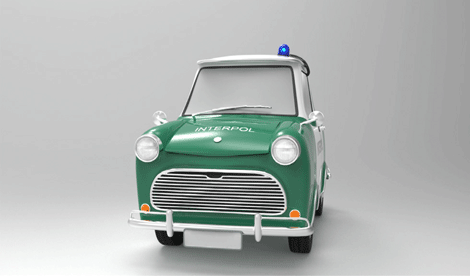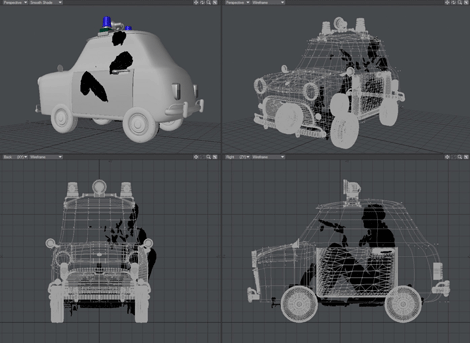 The technology which makes up 3D printing has, no doubt, been a boon to the movie industry, particularly where costumes, props, and special effects are concerned. Complicated costumes and fantastical props can be produced with far less fuss and within the infamous, film-industry budget, using 3D printing. Now, everyone’s favorite 3D characters, Jim Hensen’s iconic Muppets, will be cruising around in 3D–in a zany, cartoon-style, 3D car, to be precise.
The technology which makes up 3D printing has, no doubt, been a boon to the movie industry, particularly where costumes, props, and special effects are concerned. Complicated costumes and fantastical props can be produced with far less fuss and within the infamous, film-industry budget, using 3D printing. Now, everyone’s favorite 3D characters, Jim Hensen’s iconic Muppets, will be cruising around in 3D–in a zany, cartoon-style, 3D car, to be precise.
In their latest adventure, “Muppets Most Wanted,” released in August by Disney, major Muppets, Kermit and Miss Piggy, are swept up in an “international crime caper,” according to the film’s synopsis. Kermit’s doppelganger, “the notorious Constantine,” and Kermit are pursued by Interpol agent, Jeanne Pierre Napoleon, whose car is the 3D printed star of this article.
Charged with creating the waist-high (to humans) car, is 3D conceptual design and manufacturing company, Propshop. Propshop is based at Pinewood Studios in Iver Heath, Buckinghamshire, UK. According to the company’s website, they specialize in “providing TV and film productions with a specialist fabrication facility and talent.” They are at the cutting edge of 3D design and printing, which they combine, explains Propshop’s information page, with “traditional skills and experience.”
In order to produce Agent Napoleon’s dauntingly persistent roadster, Propshop used a combination of LightWave 3D (the most recent version, 11.6) and 3D printing. In fact, they’ve used LightWave, which “combines a state-of-the-art renderer with powerful, intuitive modeling and animation tools,” according to LightWave 3D’s site. Propshop’s 3D leading man, supervisor of the digital department, Jet Cooper, has more than 20 years of experience using LightWave software, including for the character, Cerebro, in ‘X-Men: First Class‘,” which was released in 2011. Cooper creates his 3D models in LightWave before printing them and explains that the software is also “used in the designing/concepting process, with its renderer being utilized for animations to explain a prop’s form, function, and final look.”

The 3D car was frozen to make a high-resolution poly mesh that could be exported to produce a ‘water-tight,’ printable STL file.
The basic design for the Muppet car, says Cooper, was “originally based on an old Russian car.” As it progressed through the design process, the car was transformed “to a completely different hybrid,” with “different versions that evolved as we corresponded with the movie’s art department.” The refinement process included the use of the digital sculpting and painting program, ZBrush from Pixologic. As the design team worked, they developed six different prototypes, modeling the cars, recalls Cooper, “using subdivision surfaces and concept artwork.” He continues, “The 3D car was then frozen to make a high-resolution poly mesh that could be exported to produce a ‘water tight,’ printable STL file that is used by our 3D printers.”

The car designs were modeled with LightWave 11 and polished with Pixologic’s ZBrush when and where required.
Because the car is relatively large–certainly to Muppet standards but also with respect to 3D printing parameters–numerous steps were required to prepare for the 3D printing process. The final model had to be “separated into pieces that were then further digitally cut,” says Cooper, “to fit our large printing beds.” Some of the files were big–”up to a few hundred megabytes,” Cooper added. This was “due to the fact that the planes in the geometry have to be small enough to look smooth when printed in 3D. The more organic or detailed the subject,” he clarified, “the larger the file has to be in order to produce good results on Propshop’s high-resolution printers.” In the end, the car was printed in seven parts, including the body of the car as well as accessories like the headlights.
Propshop used a Voxeljet 3D Printer to produce the cartoon car. This particular printer, says Cooper, “lays down a fine plastic powder and binding agent.” The printed object can then be modified, “tooled and finished in many different ways.” Where once Propshop would have relied on traditional techniques, sculpting out of clay and making finished props out of fiberglass, the company can now work using fewer materials and less time, which saves money and reduces waste.
How did they make that little car go, you might wonder? The 3D-printed car was fitted over, describes Cooper, “a stripped-down golf buggy.” The car needed to accommodate its driver, Jean Pierre Napoleon, along with his puppeteer. In order to make everything fit, a couple of Propshop staff members and the buggy were laser-scanned and then the LightWave model was fitted over them.
Propshop made a couple of other interesting props for the movie, including the bust of Ricky Gervais that hides a key as well as a plague-size FBI badge–chest-size for the character, Sam Eagle–and a six-foot CIA badge that is the prop in one comic scene in “Muppets Most Wanted.”
Of the wide range of unusual and challenging projects Propshop takes on, Cooper remarks, “It’s all in a day’s work.” A seriously fun day’s work, that is. Let’s hear your thoughts on yet another amazing application of 3D printing in the ‘Muppets Most Wanted’ forum thread on 3DPB.com. Check out a video clip from the film, showing the 3D printed car below.
[Source: Develop3D]Subscribe to Our Email Newsletter
Stay up-to-date on all the latest news from the 3D printing industry and receive information and offers from third party vendors.
You May Also Like
3D Printing Unpeeled: New Arkema Material for HP, Saddle and Macro MEMS
A new Arkema material for MJF is said to reduce costs per part by up to 25% and have an 85% reusability ratio. HP 3D HR PA 12 S has been...
3D Printing News Briefs, January 20, 2024: FDM, LPBF, Underwater 3D Printer, Racing, & More
We’re starting off with a process certification in today’s 3D Printing News Briefs, and then moving on to research about solute trapping, laser powder bed fusion, and then moving on...
3D Printing Webinar and Event Roundup: December 3, 2023
We’ve got plenty of events and webinars coming up for you this week! Quickparts is having a Manufacturing Roadshow, America Makes is holding a Member Town Hall, Stratafest makes two...
Formnext 2023 Day Three: Slam Dunk
I’m high—high on trade show. I’ve met numerous new faces and reconnected with old friends, creating an absolutely wonderful atmosphere. The excitement is palpable over several emerging developments. The high...
































